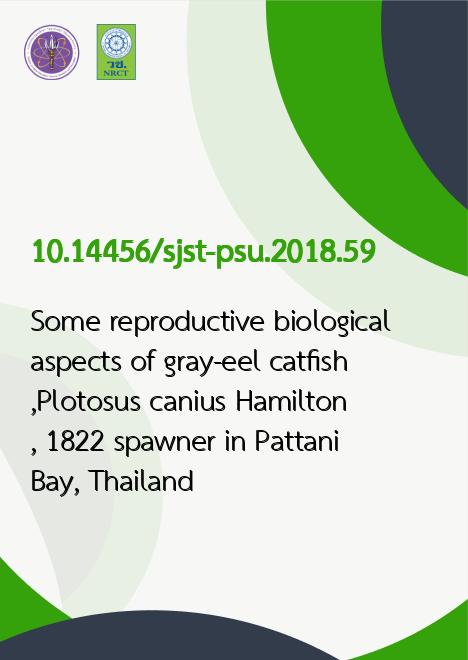
|
Some reproductive biological aspects of gray-eel catfish,Plotosus canius Hamilton, 1822 spawner in Pattani Bay, Thailand |
|---|---|
| รหัสดีโอไอ | |
| Creator | 1. Thumronk Amornsakun 2. Boonsong Krisornpornsan 3. Pairat Jirasatian 4. Thodsaphol Pholrat 5. Tan Min Pau 6. Anuar bin Hassan |
| Title | Some reproductive biological aspects of gray-eel catfish,Plotosus canius Hamilton, 1822 spawner in Pattani Bay, Thailand |
| Publisher | Research and Development Office, Prince of Songkla University |
| Publication Year | 2561 |
| Journal Title | Songklanakarin Journal of Science and Technology |
| Journal Vol. | 40 |
| Journal No. | 2 |
| Page no. | 384 |
| Keyword | reproductive biology, Pattani Bay, GSI, gray-eel catfish, Plotosus canius |
| URL Website | http://rdo.psu.ac.th/sjstweb/index.php |
| ISSN | 0125-3395 |
| Abstract | Reproductive biology of gray-eel catfish, Plotosus canius was studied at Pattani Bay by determining its year roundchanges of gonadosomatic index (GSI). Results show that the GSI was maximum in October (8.4 %), and minimum in April(0.24 %). The sampled size of sexually matured female fishes ranged from 40.9 to 60.5 cm in total length, and between 367.56 to1,159.37 g in body weight. The average total length of the female fish is 51.9 cm, with an average body weight of 788.8 g. Theaverage fecundity was 1,842.14 egg/fish. The average GSI was 10.87 % (n=14).The fish total length (TL) and body weight (BW)of the matured fish were linearly related, and could be represented by the linear regression as: BW = 32.295 TL 887.52. Therelationship between body weight (BW) and fecundity (Fe) could also be represented by the linear regression as Fe =398.67+1.83BW. The eggs were adhesive demersal egg type, and rounded. The distribution of egg's diameter could becategorized into five groups i.e. group1 (3.3%), group2 (6.9%), group3 (11.0%), group4 (54.1 %), and group5 (24.6 %), withvalues of 2.89? 0.19 mm, 3.44?0.36 mm, 4.65?0.28 mm, 5.65?0.26 mm, and 6.38?0.25 mm respectively. The spawning groundis made of silty clay soil, with sediment's pH of 7.16?0.47and water salinity of 12.06 ? 0.78 ppt. We also found that the spermsactivity was most active in the 0.9 % sodium chloride's concentration level. |
